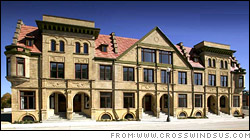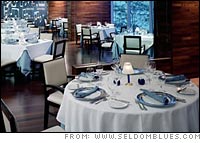(CNN/Money) – While the urban centers in most major U.S. cities are blossoming with loft apartments, gourmet restaurants and pricey boutiques, Detroit has been waiting for its renaissance.
| Market by market
|

|
|
|
|
The city's population, about 950,000 as of the 2000 Census, is half what it was in the 1950s. Grand buildings, such as the 33-story Book-Cadillac Hotel and the 18-story Michigan Central Depot have been vacant for nearly two decades, save for urban explorers and Hollywood directors scouting locations for post-apocalyptic films.
But – finally – the city of ruins may be a city on the move.
"It's a shock when you visit for the first time," said Alexander von Hoffman a senior fellow with Harvard University's Joint Center for Housing Studies and author of "House by House, Block by Block: The Rebirth of America's Urban Neighborhoods" (Oxford University Press). "But you get the sense that the worst has past."
George Barnes, Jr., who is the founder of Heritage Optical and a Detroit resident of 50 years says he knows the worst is over.
"I dare say that when Detroit hosts the Super Bowl in 2006 you won't even recognize this city," he said.
Company headquarters, loft apartments
General Motors is in the final stages of a $500 million renovation of its new global headquarters at the Renaissance Center, a move that is bringing in thousands of employees from the suburbs.
In 2003, Compuware moved 4,000 of its employees from its old suburban headquarters to its new downtown headquarters, and other companies are expected to follow.
"When you have G.M. and Compuware and others putting stakes in the ground it signals that it's not such a big bad place," said Peter Zeiler, Detroit Economic Growth Corporation and an adjunct professor at Wayne State University.
 |
|
| These nineteenth-century townhomes were recently renovated by Crosswinds Communities. |
Housing developers, restaurateurs and retailers are venturing into the city for the first time in decades. In 1994, the city of Detroit issued a handful of residential housing permits, according to Zeiler. He estimates that 3,500 permits will be filed this year.
"From 1975 to 1990 there was no market for new housing in Detroit," said Bernie Glieberman, founder and president of Crosswinds Communities, a national building and development company based in Novi, Mich. "So we built in the suburbs."
A few years ago, however, Glieberman returned to Detroit, building new condominiums and lofts near the downtown sports arenas and renovating six nineteenth-century townhomes.
Glieberman isn't alone.
In October, residents began moving into Lofts of Merchant Row, a 157-unit loft building on Woodward Avenue. Other historic buildings, including the Kales Building, once headquarters of the S.S. Kresge Company (a.k.a. Kmart), are also being redeveloped into lofts, restaurants and retail centers.
Home prices reflect the change. Over the past five years, home prices in the Detroit, Ann Arbor and Flint metropolitan area have appreciated by an average of 28 percent, according to Fiserv CSW. Prices in some zip codes in and adjacent to Detroit have appreciated more than 40 percent, significantly more than in the suburbs. (See "America's Hottest Zips")
Food and entertainment
"We had employees who were kicking and screaming because we were moving to the city," said Gayle Bonner, who worked in human resources for Compuware during its relocation. "A lot of them had never even been to the city. Then they got down here and realized how much fun they were having," she said.
 |
|
| Seldom Blues is one of 18 restaurants that opened in Detroit's central business district within the last 18 months. |
Bonner's own condominium, which is in the downtown stadium district, is now a hub of social activity for her suburban friends and family. "When I told people I was moving here they said they would never live here," she recalled. "Now they're here every weekend. My sister in Bloomfield Hills (an affluent Detroit suburb) even asked me if she and her friends could borrow my house."
Among the attractions are: Comerica Park, the Detroit Tiger's baseball stadium, which opened in 2000; the renovated Fox Theater; Ford Field, which opened in 2002 and will host the Super Bowl in February 2006; Campus Martius Park, which opened in November after a $20 million renovation and is to Detroit what Rockefeller Center is to New York.
In the past 18 months, 18 new restaurants have opened in Detroit's central business district.
"I lived in Houston and saw the revitalization there," said Frank Taylor, who co-owns Seldom Blues and Sweet Georgia Brown and plans to open two other restaurants in 2005. "I believe in what's about to happen here."
Change not without challenges
Those in the thick of Detroit's new development exude optimism. But, skeptics point out that Detroit has tried to reinvent itself before, and with no success. Crime and racial tension, they say, are just some of the challenges in the way of a bona fide renaissance.
Morgan Quitno recently released its annual "City Crime Rankings," which uses FBI statistics on murder, rape, robbery and other crime to rank cities. Last year Detroit topped the list as the most dangerous city. This year it ranked second, after Camden, N.J.
"Yes there are really tough areas, just like in New York, just like in LA., but there are also areas that are unbelievably safe," said Zeiler, adding that Morgan Quitno's rankings don't account for the fact that cities report crime data differently.
According to statistics for the Detroit Police Department's 1st precinct, which covers the central business district, there have been two homicides this year, and assaults, burglary and robberies are all down even though new neighborhoods have been added to the precinct's detail.
Stolen cars saw a minor increase, according to Commander Stacy Brackens, but that was largely because restaurant and stadium goers were getting lost. "People are still not familiar with where they are," he said. "This is a different Detroit than it was five years ago."
Though a common complaint among white suburbanites is that they don't feel welcome in Detroit, where about 80 percent of the population is black, community leaders say (you guessed it) this is a different Detroit, at least in the neighborhoods that are being redeveloped.
"Go to the new skating rink at Campus Marsius Park and you'll see a mixture of people, white, black, Asian," said Barnes. "It's refreshing. It's nothing like what people think about Detroit."
Given its size and the number of people who once lived in Detroit, said von Hoffman, it will take time for the city to turn itself around, but it's by no means impossible.
"It's true that there have been other attempts to revitalize Detroit and they did fail," he said. "But that was then."

|